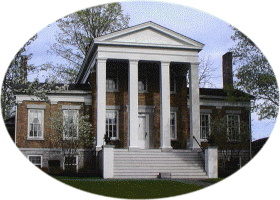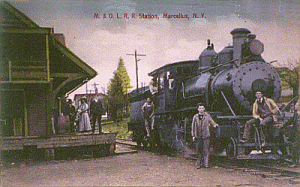- Home
- Steadman House
- Newsletters
- History Articles
Preserving the History of Marcellus, NY Since 1960.
Town of Marcellus, New York
Founded 1794Marcellus
Historical Society


MARCELLUS AND OTISCO LAKE RAILWAY . . . Bill Reagan
The first thoughts of a railroad through
Marcellus began in 1871, but never
got beyond talking. In 1897 the
Marcellus Electric Railroad Company
formed. The M.E.R.R. officers were
Edward Moir, L.N. Mogg, Edmund
Reed and John M. Seymour. Due to
Rock formations at Marcellus Falls,
the job was given up with less than two
miles of roadbed constructed.
Promoters would not give up.
With more backing, construction resumed in 1901 and the line was completed from the New York Central station at Martisco to its own station at the base of East Hill in Marcellus village.In 1903, William P. Barrows of Philidelphia purchased the railroad. Even though several trolley poles were installed, an electric train never operated on the line. Locomotive No. 1, a 2-4-0 Baldwin steamer was delivered in 1904. On May 25, 1905 the Marcellus & Otisco Lake Railway was incorporated with officers Frederick McOwen, Sylvester S. Marvin, Frederick M. Simons and William P. Barrows. Passenger service began July 1, 1905.
The line was extended another 9.05 miles to Otisco Lake and provided three round trips a day between Martisco and Marietta using two Pullman coaches which the line had purchased. In 1909 the M. & O. L. began carrying the mail to and from Martisco for the post office at Marietta and Rose Hill. Freight service was provided to the farmers for transporting their products.
The railroad tracks ran from Martisco station along the east side of the gorge road. The bed is still visible along the gorge road today. It curved around the front of the Haney residence at the base of Glover road, and crossed to the west side of the gorge road, then headed south along the east side of the Martisco Paper Mill. The railroad cut behind the house just south of the paper mill, and ran for a quarter mile just west of the gorge road and crossed over the Nile Mile Creek behind the lower Crown Woolen Mill. The tracks then continued south along the present sewer plant road and crossed North street at the base of the high school driveway.
The railroad then followed the creek behind the apartments on North street, then near the end of Paul street, crossed the creek again and ran along Limerick street where it then crossed Main street at the base of East Hill. The Marcellus and Otisco Lake Railway's village station was on the right side of Station Lane. The tracks then proceeded out of the village through the Marcellus Park and ran behind Nightingale Mills, crossing South street road near the bridge over Nine Mile Creek, and headed south to Otisco Lake.
The railroad provided freight service to the mills in Marcellus and Marietta for many years. In 1914 passenger service was discontinued on the railroad because of the construction of a stone road built around Otisco Lake in 1913, and the increased popularity of the automobile. In 1921 David Sims bought the railroad at a foreclosure sale and operated it until 1930 when Allen V. Smith took over control. In 1940 the tracks from Nightingale Mills to Otisco Lake were abandoned because trucks were cutting into the railroad's freight business. At this point the railroad became one of the shortest shortlines in the country, at only 2.84 miles. Over the years engines included No. 2, a 4-4-0 Brooks; No. 3, a 2-4-2T Baldwin; No. 12, a 0-6-0 Alco Brooks; No. 7185, two Shay 2 truck Limas; No. 7187 and No. 7025, and a diesel B-B Vulcan. Engineers on the line included Jim Miller, Jim Dillon, Henry Welsh and Bob Muldoon.
Lack of Revenue continued and on July 18, 1959 the train took its last trip. Engineer Robert Muldoon and Trainman, freight handler and switchman, John Murphy were cold the line was closed. The diesel was sold to a firm in West Virginia.
The freight station was located on what is now called Station Lane. Bob Muldoon lived in a house on the south end of the property. After the termination of the Railroad, Clifford Hayden purchased the property and started a business named Crawler Equipment in what was the Engine House. He lived in the Robert Muldoon house. He later sold the house and moved it house to its present location. The station house was torn down. The Crawler Equipment building is now S & S Tractor.
